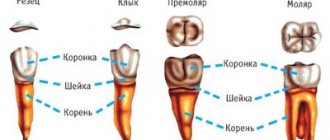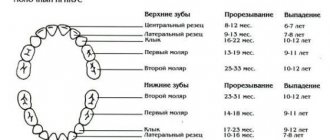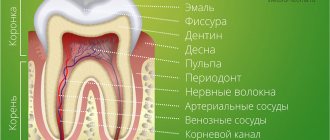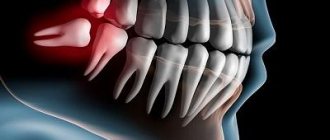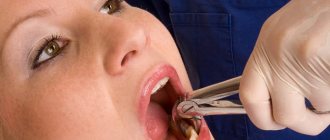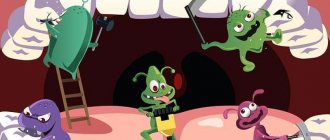Pediatric dentistry can be considered a separate section of modern dental practice, because due to the structural features, the treatment of baby teeth is somewhat different from the treatment of permanent teeth. Unfortunately, many parents are still convinced that baby teeth do not need dental care - after all, they will soon break down and fall out anyway. Therefore, children are not taken to the dentist very often, and if they are taken to the doctor, it is with advanced diseases and multiple problems.
In fact, dental treatment should be carried out at any age, and the sooner you consult a doctor with a problem, the higher the likelihood of getting rid of it quickly and without any complications. If a child has bad baby teeth, this will inevitably affect the health of his permanent ones - this is what parents need to remember when they want to “pity” the baby and not take him to an appointment with the “evil dentist.”
Home methods for removing baby teeth are not always safe
The most common way to forcibly pull out loose baby teeth at home is with a thread tied to the tooth and wound around the door handle. Some “lucky” readers probably went through this procedure in childhood and remember how unpleasant it was. Home methods for pulling teeth are not always safe. Such removal can provoke the development of infection or inflammation of the socket of the extracted tooth, which requires serious treatment. Find out what to do if the hole becomes rotten after tooth extraction.
Using improvised means, you can remove a baby tooth at home only if it is literally “hanging by a thread.” But in order not to cause psychological trauma to the child, this procedure must be made into a game.
Contraindications
There are also a number of relative and absolute contraindications, taking into account which it is not recommended to remove baby teeth with preserved roots. These include:
- Stomatitis, gingivitis, fungal infection of the oral cavity in the acute stage;
- ARVI, acute laryngitis, tonsillitis;
- Pneumonia, whooping cough and other infectious diseases.
Removal of a baby tooth with the root preserved is possible after the above diseases have been cured.
In the event that there are chronic diseases of other organs and their systems, consultation with related specialists is indicated: ENT, neurologist, gastroenterologist and others to determine the possibility of dental treatment of this type.
Little Mouse VS Tooth Fairy
Loss of baby teeth in children is associated with rituals in different countries. In Russia, back in ancient times (since the 18th century), there was a belief that a lost tooth should be put in the hole of a mouse and in return ask it for a permanent one, which will be healthy and durable.
In the West, instead of a mouse, the Tooth Fairy is popular, which exchanges a baby tooth placed under the pillow for money. This is precisely the reason why children in Russia nowadays prefer to “cooperate” with her.
Caries, pulpitis and periodontitis of primary teeth in children
Milk teeth have thinner enamel and dentin layers than permanent teeth, they have a larger pulp chamber and, therefore, infection spreads faster to the pulp. They are more often susceptible to carious lesions - and not least because of night feeding or the habit of drinking drinks from a bottle at night (mostly sweet or sweetened - tea, juices).
In addition, caries is often provoked by plaque on baby teeth, which forms faster than in adults, and which not all parents are in a hurry to remove. Many people begin brushing their children’s teeth at a more or less conscious age, while a child should be taught hygiene and regularly remove plaque from the moment the first teeth erupt, that is, from about six months of age. Also, the cause of diseases of the dental system can be an insufficient amount of solid food in the baby’s diet, since chewing solid food helps to clean the dental surfaces themselves.
The child's nutritional habits, lack of hygiene, and too thin enamel layer provoke a phenomenon called circular caries of baby teeth - carious lesions spread over the entire tooth surface, as if encircling the crown.
Caries quickly turns into pulpitis - an inflammatory lesion of the dental pulp. Most often, a doctor is consulted precisely at this stage of the infectious process, ignoring the initial stages of damage to dental tissues. Pulpitis, in turn, provokes periodontitis of primary teeth in children - inflammation of the periodontal tissues near the tips of the tooth roots. This condition is usually accompanied by severe pain, severe swelling of the affected area, and often an increase in body temperature.
In the future, people will not have wisdom teeth
It is now recognized that wisdom teeth are vestigial. This is the most problematic group of teeth, with many painful moments associated with it. When they erupt, a person may experience severe pain, inflammation, fever, and when all wisdom teeth appear, crowding of the dentition may begin. At the same time, they play almost no role in the process of experiencing food. Evolutionary changes lead to the fact that in modern times, wisdom teeth are increasingly not erupting in adults. It can be assumed that in the future they will disappear altogether.
Types of injuries to baby teeth
To choose a method to restore a broken baby tooth, you first need to determine the type of injury.
Chip on a baby tooth
A chip can occur from minor damage: a child grinds his teeth in his sleep (a common sign of helminth infection), ate solid food (crackers) or chewed a pencil, or bit a spoon unsuccessfully. When examining the oral cavity, it is discovered that a piece of the child’s baby tooth has broken off, the lower edge of the crown has become uneven and scratches the tongue. In this case, it is important to determine the extent of the damage.
If a red dot is visible on the surface of the chip, then the injury is serious and affects the pulp (nerve). And although the child will complain of acute pain when eating cold/hot food, the broken tooth can be saved.
Horizontal crack
A crack indicates an incomplete fracture of the tooth. The baby tooth has not cracked, but the crown is loose, and when the teeth are closed and biting, a sharp pain appears. The most difficult case is when the child fell, the tooth did not break off, but a crack appeared on the crown along the edge of the gum. In this case, you will likely need to strengthen the tooth with a thin veneer.
Baby tooth broken at the root
Did the kid bring a broken tooth in his hand? Unfortunately, with such an injury, it will not be possible to restore the integrity of the dentition. However, you still need to go to the dentist in order to remove the remaining fragments from the gums.
Impacted tooth fracture
With such an injury, the tooth is partially immersed in the gum. The length of the tooth is reduced compared to other crowns, but its edge is not sharp and does not scratch. Characterized by diffuse pain in the jaw. Sometimes the injury is accompanied by heavy bleeding due to the many small vessels in the gums of children.
Fractures of the alveolar process and jaw due to impacted tooth trauma are extremely rare, since the roots of baby teeth are quite short. Damage to bone tissue is indicated by severe pain spreading throughout the entire jaw on one side, the inability to open the mouth wide and a change in the bite.
Displacement of a baby tooth
With a strong blow, damage to the coronal part may be accompanied by complete or incomplete dislocation. A child’s tooth (often a front one) breaks off and takes an unusual position in the socket: it moves to the side, moves forward or backward, and turns around its axis. In this case, the tooth becomes loose, causing pain, and the child refuses to eat. The gums swell a little. In case of such an injury, the tooth is saved, but treatment may last several weeks.
Important! A chip in a baby tooth allows bacteria access to the dentin. Caries appears on the damaged crown. This often leads to its destruction within a couple of months and tooth loss.
What are the dangers of early removal of baby teeth?
If a temporary tooth is forced to be removed before its natural loss by more than a year, then we are talking about early removal. This situation provokes malocclusion and improper development of the entire dental system, including delayed jaw growth.
Neighboring teeth strive to take the place of their distant counterpart, and all of them are displaced.
adjacent teeth and their roots, antagonist teeth also move into the resulting free space. As a result, permanent teeth can erupt chaotically and even outside the dentition. In the future, such a problem will require long-term orthodontic treatment.
In addition, earlier removal of chewing teeth leads to a redistribution of the load on the front teeth, which, in turn, begin to collapse.
Therefore, it is so important to strive to keep all baby teeth in their places for as long as possible, preferably until the time of their natural replacement.
What reactions of a child’s body are possible during the period of loss of baby teeth and growth of permanent teeth?
Replacing teeth is almost painless. The loss of baby teeth occurs on their own after their root is completely absorbed or removed at home, and if the permanent tooth is already growing, but the permanent one has not yet fallen out, the help of a pediatric dentist is required. When permanent teeth erupt, pain usually does not occur. Very rarely, there may be a slight increase in body temperature, itching of the gums or discomfort in the abdomen. In this case, the child does not need treatment, but it is recommended to visit a dentist.
Treatment of tooth root resorption
The doctor chooses a technique in each specific case, taking into account the complexity and characteristics of the patient’s body. The dentist may resort to cleaning the canals and sealing them. When the process is advanced, when irreversible resorption of tooth roots is observed, removal of the unit followed by prosthetics or implantation is indicated.
In the early stages of small lesions, the surgeon removes the infected areas by making an incision in the gum.
If the cause is a tumor or an improperly growing adjacent tooth, then the tumor is removed surgically; the interfering or pathological unit (the choice is made by the doctor depending on the indications) is in most cases removed.
How to determine if a child has bad baby teeth
A child's rotten front teeth are immediately visible. These are dark or yellow spots of enamel, reddened gums, and damaged edges. But sometimes decay begins on the distant teeth - molars, premolars, and then you need to focus on indirect signs.
The fact that a child is growing bad teeth is indicated by:
- complaints of pain and discomfort - reaction to toothpaste, hot or cold foods;
- unpleasant odor from the baby’s mouth - putrid, pungent;
- change in enamel color - the appearance of dark stripes, yellow or dark spots;
- development of dental diseases - caries, pulpitis.
Any of the listed factors indicates the need for consultation with a pediatric dentist - a full diagnosis and timely treatment.
Types of resorption
There are also two types of resorption, each of which, without treatment, can provoke complete tooth loss or partial tooth loss.
Internal resorption
Dentin (or cement shell) is absorbed into the root canal, dissolves, and disappears. Inflammation begins inside the tooth and then spreads to the outer surfaces. Usually the cause of the pathology is injury, burn (thermal, chemical), infection. Inflamed cells increase in size. The structure of soft and hard tissues changes. Symptoms of resorption:
- Changing the shade of the dental unit to pink. The tissue of the neurovascular bundle turns into granulomatous. After dying it turns gray.
- Painful sensations appear.
- The mobility of the units is noticeable.
Without diagnosis, the tooth becomes an empty shell. It is susceptible to caries, fragile - it splits at the slightest load. In the early stages, it is detected during preventive examinations or as a concomitant option in the treatment of other teeth.
External resorption
The reason is a consequence of injury, infection or a rapid change in the position of the roots (possible when installing braces). The enamel also changes color to medium red or pink. Develops at the junction with the tissues of the jaw. Causes:
- The action of pathogenic microflora inside the root canal.
- Dislocation of teeth.
- Necrosis of the nerve bundle.
There are no obvious symptoms. Blood capillaries of the gums and surrounding tissues penetrate into the tooth root, changing the shade of the crown. Changes can be detected by taking an x-ray. Rarely diagnosed in the early stages, loss of chewing teeth or loss of central teeth is possible. Doctors note an aggressive course, rapid development with extensive destructive processes, resorption of the dental bone tissue begins.
